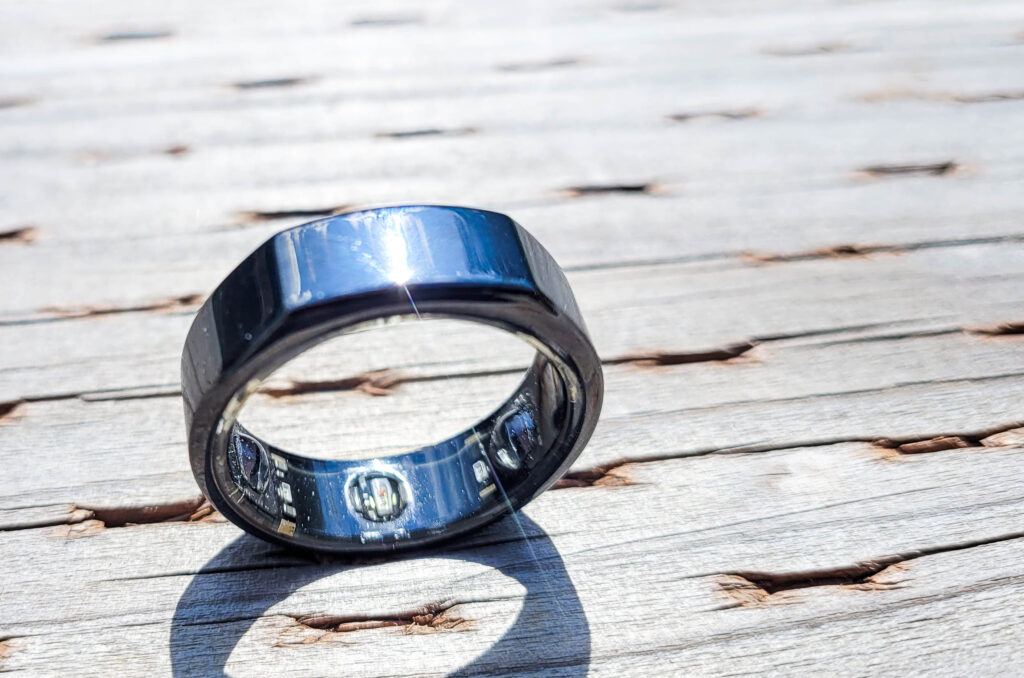Oura Ring Generation 3 Smart Ring
The Generation 3 Oura Ring from Oura Health is a wearable device focused on collecting, tracking, and presenting user generated physiological data. An impressive collection of sensors are packed into this device allowing users to track trends in sleep, heart rate variability, activity level, and body temperature. While these sorts of wearable sensors are currently targeted at consumers, this sort of unobtrusive health monitoring technology represents an emerging trend in healthcare technology that could enable improved detection, prevention, and treatment of a variety of health issues.
About the Oura Ring
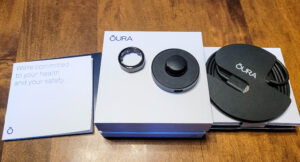
The Oura Ring is offered in 8 sizes (numbered 6-13), with wearers able to find the correct size using an indexing kit that is sent to their home in advance of the ring being shipped. The ring is generally bulkier in width and height than most typical rings. For those with medium or larger sized hands and fingers the Oura ring is comfortable enough to be worn continuously, and generally won’t interfere with most daily activities*. For individuals with smaller hands and fingers the form factor may be more noticeable (this is a common issue for many wearable devices in both watch, ring, and band form factors).
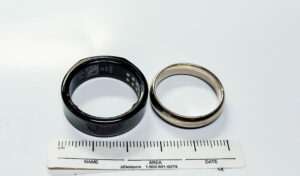
Our testing unit has stood up to near daily use for over 6 months with only slight scuffing apparent on some of the edges of the plastic surface. Swimming and bathing have had no observable effect on the device. There are three small bumps along the lower surface of the ring which contain the infra-red LED sensors, seven small temperature sensors mounted flush against the device surface, and eight flush mounted copper pads (behind the plastic enclosure) that are used to charge the device using the ring stand provided in the kit.
Charging and Battery Life
The ring takes between 30 and 40 minutes to fully charge from a completely discharged state. The device comes with a USB-C to USB-A type cable, but does not include a charging brick. The charging stand has a post which holds and aligns the ring for wireless charging. Charge status is displayed by a simple led indicator that blinks during the charge cycle and shows solid light when the device is fully charged.
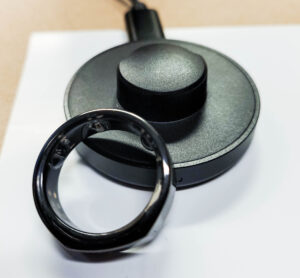 Our time with the Oura ring showed a usage time of between 4 and 5 days between charges. This long battery life, and the relatively quick charge time means that the device has significant “up” time when it is collecting data. This is particularly helpful for tracking sleep patterns.
Our time with the Oura ring showed a usage time of between 4 and 5 days between charges. This long battery life, and the relatively quick charge time means that the device has significant “up” time when it is collecting data. This is particularly helpful for tracking sleep patterns.
For increased collection time the ring can be placed into “Airplane Mode” which disables the Blue Tooth connectivity of the device to the health app, keeps stored data on the ring itself, and increases collection time up to around 14 days per the manufacturer. The Oura ring can be returned to normal function by placing it back onto the charging stand and re-syncing with the app (more on this later). We found this mode to be somewhat problematic as when the device did connect the time needed to sync the data could be substantial (20 minutes or more) and we found gaps in some of our activity and sleep data.
Oura App and Data Presentation
The ring transmits collected data to a smartphone (Android and IOS) app using encrypted Low Energy Blue Tooth (BTLE) connectivity and syncs that data into the Oura Health cloud. Data from the ring syncs to the app when the app is open, meaning that the app should be opened daily for results to sync. We found that opening the app after waking in the morning was a good opportunity to sync the ring and app, check on the remaining battery level of the ring, review the previous night’s sleep data, and compare the app’s scoring and recommendations with how we felt each day.
Initial setup of the app was straightforward and consisted of
- Downloading the app from the Google Play store (for our android device)
- Creating a user account and signing into the app
- Performing an initial sync/pairing of the ring and device
- Creating a user profile with
- Date of Birth
- Weight
- Height
- Gender
- Adding Goals and life situation
- Adding a current goal from a list of health and productivity options- of note only one goal could be selected at a time- we chose “Improve my health”
- Indicate how your sleep is at the moment
- Indicate factors that could be affect your sleep like:
- Shift work
- Children
- Stress
Data is presented in the app primarily through the use of three daily score values: Sleep, Activity and Readiness. These scores represent calculated score based on combined sensor values reflected on a 100 point grading scale. Scores ranging from around 85 to 100 are optimal, scores around 70 to 84 are good, and scores below are flagged as “Pay Attention”.
Sleep Score
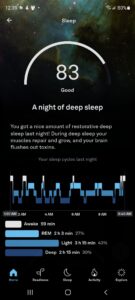
The Sleep Score uses heart rate, heart rate variability, movement, and temperature to measure the amount and levels of sleep. It is challenging to verify the accuracy of sleep data from these devices. When compared to other sleep monitoring apps we found the duration of sleep was fairly consistent between devices, however the level of sleep (Light, Deep, REM, etc.) was highly variable between different devices. Additionally, the Oura (as well as other devices we evaluated) had trouble differentiating between times spent sleeping versus time spent in very low activity tasks (like watching television in bed).
In our focus groups as well as our internal evaluation sleep score was one of the most valuable data points from the Oura ring. The Oura ring did a good job of showing trends in sleep patterns, identifying and recommending ideal bedtime and sleep preparation, and in providing advice for better sleep (like reducing food intake around bedtimes).
Activity Score
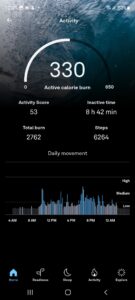
The Activity Score uses heart rate, heart rate variability and movement readings to identify the amount, duration and intensity of daily activities. Activity is calculated based on the amount of measured inactive time, active time, and recovery (which seems largely based on the Heart Rate Variability measurement). The Oura ring also features an activity goal measure which allows users to set an activity goal and verify how often they meet that goal. In addition to automatically detecting workouts and activities based on movement (the Oura ring was able to detect walking and jogging in our tests) users also have the ability to manually enter activities, or tie in other software like Google Fit or Apple Health.
Movement reminders and other notifications are sent via app notifications. There is no buzzing or alerts from the ring itself. This more passive approach allows for a less distracting experience, but requires the user to interact with the app and notifications to obtain insights.
Readiness Score
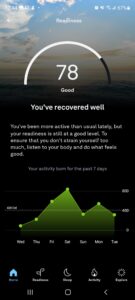
The Readiness Score uses calculations from the Activity Score, Sleep Score, temperature and heart rate variability to provide an overall rating of readiness. This is a sort of hybrid key score for the Oura app and appears at the top of each day’s overview card. Below this score is a general question or statement that relates to your score (“Feeling refreshed?”, “Optimal HRV balance”, “Keep going” were some of the messages we saw) and a (and each other score) is a brief descriptor describing key trends detected, and recommended advice for the day.
The Readiness score is a nice summary value for those wanting to see an at-a-glance value that contains insight into their previous day.
Additional Features
Oura Web Portal- Log into the O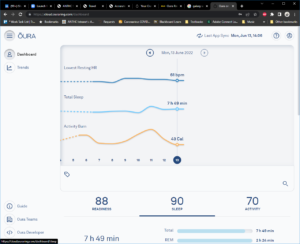 ura Ring web portal with your username and password to view and track trended data in dashboard and trend views. You can also select specific values to download into CSV documents for your own analysis.
ura Ring web portal with your username and password to view and track trended data in dashboard and trend views. You can also select specific values to download into CSV documents for your own analysis.
SpO2- The Oura Gen 3 Oura ring has infra-red sensors to capture SpO2 data, but this feature has not been activated as of June 2022- though it is scheduled for release later this year.
Cost and Subscription
The base cost for the standard Oura ring is $299 USD for the Silver and Black finishes and $399 USD for the Stealth (Matte) or Gold finishes. Rings ship with six month of Oura Membership services for free with a subscription charge of $6/month after that.
Overview
The Oura ring is an unobtrusive health monitoring device that boasts substantial battery life and a comfortable design that will be pleasing to most wearers. While not offering the active alerting and feedback of many of the many wearables we have reviewed, collected data is shared in a straightforward and useful manner that can be actionable for users. This is a consumer focused device, but the ability to monitor such a wide variety of vital signs in such a small form factor has future potential in monitoring and management of disease and health risks.
*Oura Health recommends removing the Oura ring when lifting heavy objects, or when working with materials that could scratch or damage the device.
From time to time TAC will choose a piece of technology to show or demonstrate in the “Innovation Watch” section of our website. No endorsement of any products or services is expressed or implied by any information, hyperlink text, product, service, material or content referred to or included on, or linked from or to the TTAC web site.

